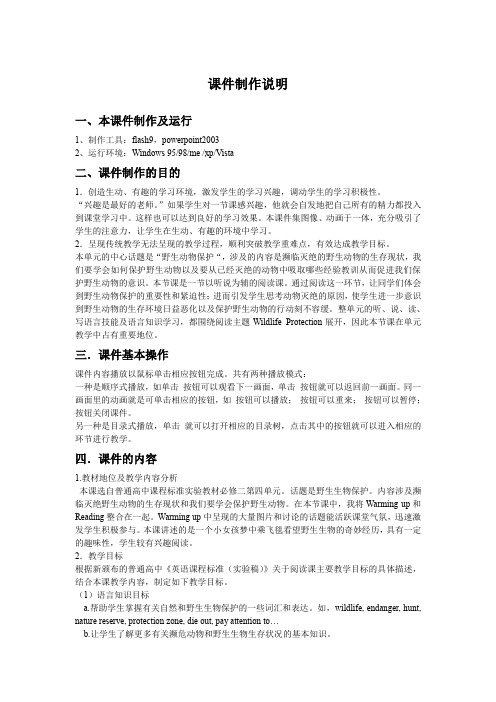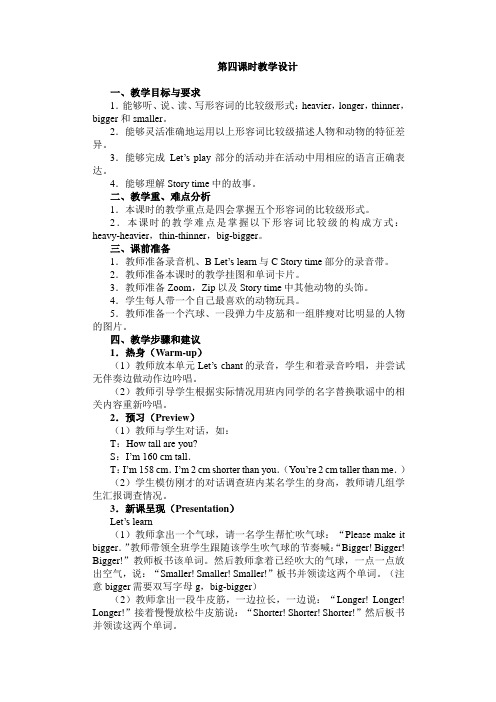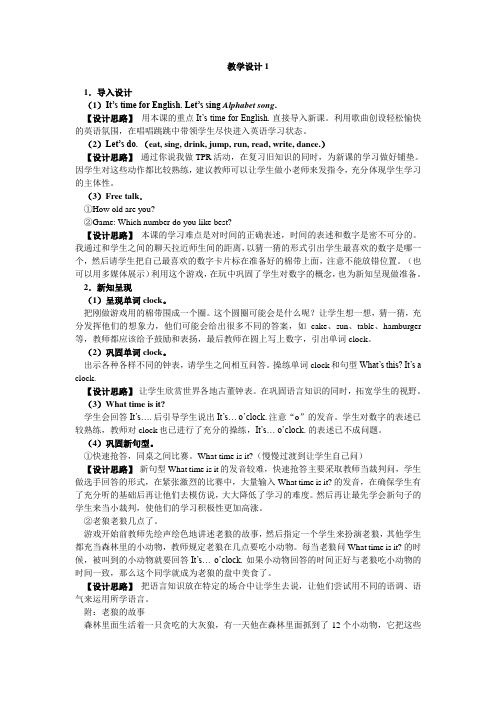Unit 2第四课时教学设1.DOC
- 格式:doc
- 大小:47.50 KB
- 文档页数:3


课题Unit 4 CustomerService( Listening andspeaking)课型Listening andspeaking课时2授课班级授课时间90mins授课教师教材分析本课教学内容选自高等教育出版社出版的“十四五”职业教育国家规划教材,《英语3 基础模块》中第四单元的热身(Warming Up)和听说(Listening and Speaking)板块,本单元主题是售后服务,听说板块的语料分别是手机维修和运动手表退换的服务场景对话,要求学生能在听说的过程中提取双方的问题和态度,能以顾客的身份表达需求,以服务者的身份处理投诉,培养职场语言沟通能力,思维差异感知能力,提升职业素养。
学情分析学生基本掌握购物时顾客与服务员常用的一些语言,但还不熟悉关于售后服务的表达,不明确如何表达顾客自己的需求,不会以服务者的身份处理投诉,对语境中如何礼貌而有效的实现投诉和处理投诉,也缺乏相应的语言储备和迁移能力,但是思维活跃,服务意识强,喜欢在“真实的情景中”进行语言学习。
教师应采取由浅入深的教学策略,先为学生扫除词汇障碍,然后积攒语言的输入,再由模仿到角色扮演练习,最终实现语言的输出。
培养职场语言沟通能力,体现诚信和顾客至上的服务态度,同时坚守按照工作程序办事的职业原则。
学习目标Knowledge objectives:To learn words and phrases about complaint:complaint,apology,refund,blank screen,even if,charge,inconvenience ,receipt,under guarantee,patience.To be able to use these sentences skillfully:The dish is too.../It is the wrong.../There is something wrong with .../I’d like to have...repaired./Excuse me, I’d like to make a complaint./I’m sorry for the inconvenience caused./Thanks for your patience.Ability objectives:To be able to make a complaint and deal with the complaint in different situations.To improve listening skills.Emotional objectives:To develop a sense of service and adhere to professional principles.To recognize the value of honesty in doing business.学习重难点To be able to make a complaint and deal with the complaint in different situations.To master the expressions about how to make and deal with a complaint.教学方法小组讨论法、任务教学法、情境教学法课前准备PPT课件,语音素材,图片教学媒体PPT课件、多媒体设备、语音素材、拓展资源包等教学过程教学环节教师活动设计学生活动设计设计意图Step 1: Lead in 1.Ask and answer:What after-sale problems haveyou had in your life?Wrong delivery, damaged items,package delay,packet loss, quality problem, price change,wrongcolors, return and exchange ...2.Play a video to find out what after-sale problemsthe lady has.The couch was not built the same.There are scratches and stains on the dining table.The carpet was wrong color.Replace all the damaged items and the wrongcarpet. /Have a discount.1.Brainstorm theirexperiences aboutafter-sale problems.2.Find more after-saleproblems in life.激活词汇储备,学生说出售后常见问题的英文表达,教师提供图片和模拟情景作为提示,以激活学生思维,为后续的听说活动做准备。

课件制作说明一、本课件制作及运行1、制作工具:flash9,powerpoint20032、运行环境:Windows 95/98/me /xp/Vista二、课件制作的目的1.创造生动、有趣的学习环境,激发学生的学习兴趣,调动学生的学习积极性。
“兴趣是最好的老师。
”如果学生对一节课感兴趣,他就会自发地把自己所有的精力都投入到课堂学习中。
这样也可以达到良好的学习效果。
本课件集图像、动画于一体,充分吸引了学生的注意力,让学生在生动、有趣的环境中学习。
2.呈现传统教学无法呈现的教学过程,顺利突破教学重难点,有效达成教学目标。
本单元的中心话题是“野生动物保护“,涉及的内容是濒临灭绝的野生动物的生存现状,我们要学会如何保护野生动物以及要从已经灭绝的动物中吸取哪些经验教训从而促进我们保护野生动物的意识。
本节课是一节以听说为辅的阅读课。
通过阅读这一环节,让同学们体会到野生动物保护的重要性和紧迫性;进而引发学生思考动物灭绝的原因,使学生进一步意识到野生动物的生存环境日益恶化以及保护野生动物的行动刻不容缓。
整单元的听、说、读、写语言技能及语言知识学习,都围绕阅读主题Wildlife Protection展开,因此本节课在单元教学中占有重要地位。
三.课件基本操作课件内容播放以鼠标单击相应按钮完成。
共有两种播放模式:一种是顺序式播放,如单击按钮可以观看下一画面,单击按钮就可以返回前一画面。
同一画面里的动画就是可单击相应的按钮,如按钮可以播放;按钮可以重来;按钮可以暂停;按钮关闭课件。
另一种是目录式播放,单击就可以打开相应的目录树,点击其中的按钮就可以进入相应的环节进行教学。
四.课件的内容1.教材地位及教学内容分析本课选自普通高中课程标准实验教材必修二第四单元。
话题是野生生物保护。
内容涉及濒临灭绝野生动物的生存现状和我们要学会保护野生动物。
在本节课中,我将Warming up和Reading整合在一起。
Warming up中呈现的大量图片和讨论的话题能活跃课堂气氛,迅速激发学生积极参与。

第四课时教学设计一、教学目标与要求1.能够听、说、读、写形容词的比较级形式:heavier,longer,thinner,bigger 和 smaller。
2.能够灵活准确地运用以上形容词比较级描述人物和动物的特征差异。
3.能够完成Let’s play部分的活动并在活动中用相应的语言正确表达。
4.能够理解Story time中的故事。
二、教学重、难点分析1.本课时的教学重点是四会掌握五个形容词的比较级形式。
2.本课时的教学难点是掌握以下形容词比较级的构成方式:heavy-heavier,thin-thinner,big-bigger。
三、课前准备1.教师准备录音机、B Let’s learn与C Story time部分的录音带。
2.教师准备本课时的教学挂图和单词卡片。
3.教师准备Zoom,Zip以及Story time中其他动物的头饰。
4.学生每人带一个自己最喜欢的动物玩具。
5.教师准备一个汽球、一段弹力牛皮筋和一组胖瘦对比明显的人物的图片。
四、教学步骤和建议1.热身(Warm-up)(1)教师放本单元Let’s chant的录音,学生和着录音吟唱,并尝试无伴奏边做动作边吟唱。
(2)教师引导学生根据实际情况用班内同学的名字替换歌谣中的相关内容重新吟唱。
2.预习(Preview)(1)教师与学生对话,如:T:How tall are you?S:I’m 160 cm tall.T:I’m 158 cm.I’m 2 cm shorter than you.(You’re 2 cm taller than me.)(2)学生模仿刚才的对话调查班内某名学生的身高,教师请几组学生汇报调查情况。
3.新课呈现(Presentation)Let’s learn(1)教师拿出一个气球,请一名学生帮忙吹气球:“Please make it bigger.”教师带领全班学生跟随该学生吹气球的节奏喊:“Bigger! Bigger! Bigger!”教师板书该单词。

教学设计11.导入设计(1)It’s time for English. Let’s sing Alphabet song.【设计思路】用本课的重点It’s time for English. 直接导入新课。
利用歌曲创设轻松愉快的英语氛围,在唱唱跳跳中带领学生尽快进入英语学习状态。
(2)Let’s do. (eat, sing, drink, jump, run, read, write, dance.)【设计思路】通过你说我做TPR活动,在复习旧知识的同时,为新课的学习做好铺垫。
因学生对这些动作都比较熟练,建议教师可以让学生做小老师来发指令,充分体现学生学习的主体性。
(3)Free talk.①How old are you?②Game: Which number do you like best?【设计思路】本课的学习难点是对时间的正确表述,时间的表述和数字是密不可分的。
我通过和学生之间的聊天拉近师生间的距离,以猜一猜的形式引出学生最喜欢的数字是哪一个,然后请学生把自己最喜欢的数字卡片标在准备好的棉带上面,注意不能放错位置。
(也可以用多媒体展示)利用这个游戏,在玩中巩固了学生对数字的概念,也为新知呈现做准备。
2.新知呈现(1)呈现单词clock。
把刚做游戏用的棉带围成一个圈。
这个圆圈可能会是什么呢?让学生想一想,猜一猜,充分发挥他们的想象力,他们可能会给出很多不同的答案,如cake、sun、table、hamburger 等,教师都应该给予鼓励和表扬,最后教师在圆上写上数字,引出单词clock。
(2)巩固单词clock。
出示各种各样不同的钟表,请学生之间相互问答。
操练单词clock和句型What’s this? It’s a clock.【设计思路】让学生欣赏世界各地古董钟表。
在巩固语言知识的同时,拓宽学生的视野。
(3)What time is it?学生会回答It’s…. 后引导学生说出It’s… o’clock. 注意“o”的发音。

选修必修四Unit2 Iconic Attractions分课时教案课题Reading and Thinking 教学设计主备课人:郑莉君卢菁审核人:张月仙授课时间:____________________ Reflections on multiculturalism______ Political divisions_____ First impressions_____ Preparing to travel_____ Aborigines and the didgeridooStep 4. Detailed readingRead the text 1 - 3 , please underline the key information and draw your own notes for each blog entry. We will finish blog 1 together, and blog2 and blog3 will be showed by some of you.Read blog1 for key information:Next week I’m travelling to Australia to visit a friend there over the school holidays. I plan to keep this blog to record my experiences and what I learn. I have already ___________ on the country. ______ to the south of the equator, below many other countries on the globe, it’s often informally _________ “__________”. I have also read about some ________, such as the ___________________ and the ____________________, and animals like the cute _____ and __________. I can’t wait to see all of them! However, as I major in social studies, I’m more interested in meeting people in Australia and experiencing their culture, food, and way of life. Your notes for blog 1:Read blog2 for key information:I’m here in Sydney! Since I arrived, my friend has brought me to my first ______________ and has also shared many different but ___________ with me, so my first impressions of Australia have been all about food! A lot of __________________, such as the Sunday roast, is originally British. Bakeries, _____________, ____________, cafes, and restaurants everywhere provide some of the ______________________ in the world. The influence of Asian cultures, _______________, led to the introduction of ____________ and ____________, along with Australian versions of foods like the _________________ dim sim.Your notes for blog 2:(students’ work is being shown here)Read blog3 for key information:My friend and I have arrived in Katherine, a town in Australia’s Northern Territory. We’re here to learn about the _____________ of the Aborigines, who ___________ Australia. The Aboriginal population might be small, but its _________ is still visible. For example, “Bondi”in “Bondi。
课时教学设计课题M4U2 He invented this bicycle. 课型新授课时 1学习目标1.在看、听、说的活动中,获取、梳理国外关于交通工具的发明创造,并能够认读、理解、运用、书写between, beside, in front of, behind等方位介词;(学习理解)2.在图片的帮助下,能够运用一般过去时态描述外国的伟大发明创造,进一步注意到中外文化的不同;(应用实践)3.通过与文本人物对话,以小组合作的方式,选择、书写、交流展示自己所要感恩的发明家,树立国际视野,坚定文化自信。
(迁移创新)教学重难点1.听音回答问题,获取、梳理国外发明创造,正确使用方位介词。
2.正确、流利运用对话交流,描述国外发明创造。
3.运用核心句型交流展示所要感恩的发明家。
学习内容基于单元主题意义和整体教学架构,指向课时目标达成的课时学习内容过程设计环节学习活动评价标准Step1 情景导入复习旧知引入主题1.歌曲热身:通过演唱歌曲,复习三个重点方位词:in front of, behind,between,欢快的歌曲及动作充分调动了学生的积极性。
学生在欢快的旋律中,自主地加入到歌曲的唱跳中。
开启欢快的英语课堂之旅。
2.复习导入:教师带领学生复习上一课Sam印刷报纸的故事,进一步复习方位词between。
学生观察图片、观看视频回答Where is the mouse?学习新的方位词beside。
回忆复习上节课关于中国伟大的发明,并强调上节课出现的方位介词。
并乐于跟着老师学习新的方位介词。
设计意图:用学生已知的内容来与学生互动,使学生在轻松的氛围中开始了英语的学习,既复习了旧知,又可以巧妙地加入新词的学习。
Step 2 新知学习1. Listen and say:(1)学生观看活动二视频,理解对话大意,完成学习单上的连线和填空,并让学生讨论后在黑板上把图片贴到合适的位置,学生学会用beside和between描述人或物的位置。
Unit 2第四课时教学设计
【课题】Unit 2 Where is the science museum?
【教学重点】1、四会短语:go straight,turn left,turn right。
2、单词:north, south, east, west。
【教学难点】单词straight的发音容易和street混淆。
【教具准备】1、Let’s learn部分的课件和录音。
2、兔子舞的录音。
3、Story部分的课件。
4、中国地图。
5、一块能蒙住眼睛的布,一面彩旗和教材P22的map挂图。
6、A部分几个场所单词的卡片。
【教学过程】
1、Warm up (热身)
活动一:复习对话
教学参考时间:3分钟
(1)(1)教师请学生分角色朗读A部分Let’s read的对话。
(2)(2)提问:How can Chen Jie get to the hospital? 引导学生朗读:Go by the No. 301 bus. Get off at the cinema. Then walk straight for three minutes. The hospital is on the left.
(3)(3)引导学生说出walk straight的另一种表达方式:go straight。
活动二:兔子舞
教学参考时间:3-4分钟
(1)(1)教师播放兔子舞的录音,学生表演,教师要适时强调单词left和right。
(2)(2)带领学生边表演边说唱歌谣:Left hand, left hand, show me your left hand.
Right foot, right foot, stamp your right foot.
2、Presentation (新课呈现)
活动三:学学做做
教学参考时间:5分钟
(1)(1)教师边演示边说:This is my left hand. This is my right hand. This is my left arm.
This is my right arm. ( eye, ear, leg, foot ) 出示单词:left,right学生朗读。
(2)(2)教师出示示意图,指图讲解:Here is the street. Go straight you can see a school.
Then turn left, you can see a museum. Turn right, you can see a library.
school
(3)(3
(4)(4)呈现单词street和
师朗读任意单词,学生根据听到的发音说出中文;教师强调straight中ai发[ei],ght 发[t],帮助学生进行拼写的记忆。
(5)(5)学生起立,教师说指令:Turn left, turn right, go straight,学生做动作。
(6)(6)教师播放Let’s learn B部分对话,学生跟读。
活动四:认识方向词
教学参考时间:5分钟
(1)(1)教师出示中国地图指着几个城市分别介绍:Harbin is in the north of China.
Hainan is in the south of China. Shanghai is in the east of China. Lasa is in the west of
China.学生感知单词south,north,east,west的读音和意思。
(2)(2)教师点击单词south,north,east,west,学生跟读,再次重复刚才的句子,
让学生根据几个城市的位置理解四个方向词的意思。
(3)(3)提示学生单词的发音规律:north中or和th的发音;south中ou和th的发音;east中ea的发音,帮助学生快速掌握单词。
(4)(4)请学生看地图说句子:… is in the … of China.
3、Let’s play (趣味操练)
活动五:画鼻子
教学参考时间:3分钟
教师在黑板上画一张没鼻子的脸,给一名学生蒙上眼睛,该生走到黑板前画鼻子,组内其他同学可以用go straight,left,right提示正确位置。
展开小组间的竞赛。
活动六:插彩旗
教学参考时间:5分钟
(1)(1)教师出示教材P22的map挂图,准备一面彩旗和一块蒙眼布。
(2)(2)将学生分为两大组,各组选一名代表到前面,其中一人发指令,另一人将彩旗插在正确的位置上(眼睛上蒙上布),如果插得不对,组内成员可以提醒,如:West! East! Left!…. 但是提醒的次数不得超过三次。
然后换人参赛,插队一次得一分,看哪组的得分高。
(3)(3)选出优秀组进行奖励。
活动七:排一排
教学参考时间:3-5分钟
(1)(1)教师出示图:east
(2)学生四人一组,每组使用一套表示场所的单词卡片。
(3)教师发指令,如:The post office is west of the library. The cinema is north of the bookstore.
等等,学生根据听到的内容进行场所的排列,也可以让学生之间互相发指令进行排列练习。
4、Consolidation and extension 巩固与扩展
活动八:阅读故事
教学参考时间:4分钟
(1)(1)教师播放Story time的课件,学生观看,初步了解故事的意思。
(2)(2)学生自己阅读故事。
(3)(3)教师解释:Chinatown唐人街,Look before you leap.三思而后行,tart 酸。
(4)(4)提问:How can get to the Chinatown? 引导学生找到句子:You can take the No.
8 bus to go there.来回答。
活动九:练一练
教学参考时间:5分钟
活动手册P11练习
(1)(1)Listen , write the places and say
a、a、教师播放录音2遍,第一遍学生听,第二遍完成单词的填写。
b、b、分别请四个学生说出答案,并拼读单词,其他学生交换批阅。
c、c、教师了解学生完成的情况。
(2)(2)Look at the map and write
a、学生独立完成:
How can I go to school?
First, go straight. Turn left at the second traffic lights. Then go straight again. Next, turn right at the library. Then go straight. Yo u’ll see the school.
b、小组讨论答案,互相纠正改错。
活动十:小结
教学参考时间:1-2分钟
出示单词和词组,学生朗读。
go straight。